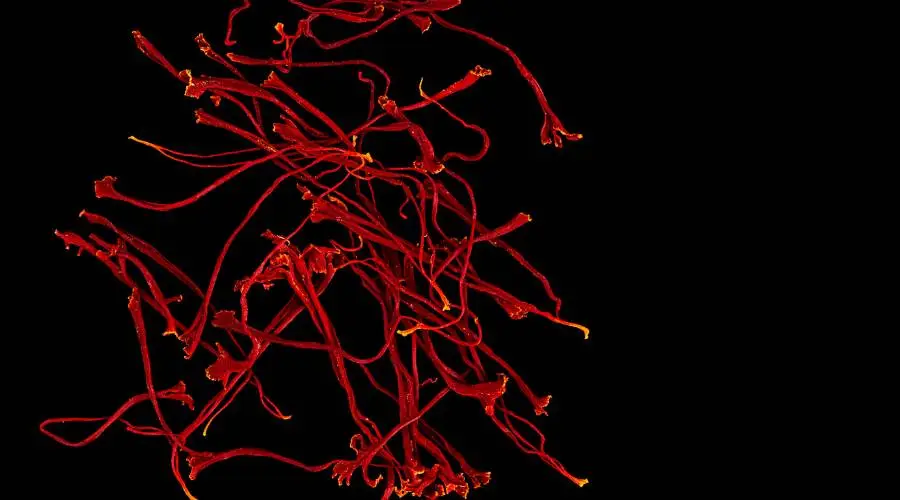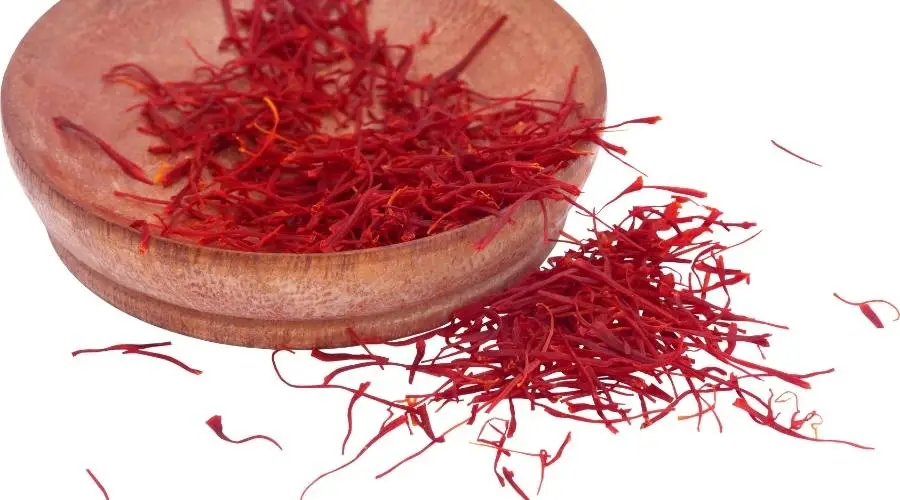📌 Quick Answer: Saffron is generally safe in culinary amounts (5-15 threads daily) but can cause side effects, including mild headaches, dizziness, nausea, and allergic reactions in supplement form. High doses above 5g can be toxic, causing liver damage and cardiac issues. Pregnant women should avoid therapeutic doses, and those on blood thinners or antidepressants should consult healthcare providers before use.
Saffron is a highly valued spice used in Mediterranean, Middle Eastern, and Persian cooking, where its golden strands add delightful aroma and flavor to dishes such as biryanis and baklava. Understanding what saffron is helps appreciate why this precious spice has gained popularity as a dietary supplement, known for potential health benefits like mood improvement and antioxidant support.
However, it’s crucial to understand that saffron may also have side effects, particularly when used in therapeutic quantities beyond normal culinary applications. This comprehensive guide provides essential safety information for those considering saffron supplementation, ensuring informed decision-making about this powerful natural remedy.
Medical Professional’s Note: While saffron offers promising therapeutic benefits, responsible use requires understanding both its potential and limitations. As with any bioactive compound, individual responses can vary significantly, making professional guidance essential for safe supplementation.

The Therapeutic Benefits and Risks Balance
Before examining potential adverse effects, it’s important to understand why people turn to saffron supplementation and the comprehensive health benefits of saffron that drive interest in therapeutic applications.
Established Health Benefits
Antioxidant Protection: Saffron’s antioxidant properties stem from powerful compounds including crocin, safranal, and picrocrocin. These bioactive elements help protect cells from damage caused by harmful free radicals, which are associated with aging and chronic diseases.
Key Antioxidant Compounds:
- Crocin: Provides vibrant color and demonstrates strong cellular protection
- Safranal: Creates a characteristic aroma while offering antioxidant effects
- Picrocrocin: Contributes to flavor profile and cellular defense mechanisms
Mental Health Applications: Research demonstrates saffron’s potential for depression treatment and anxiety relief. Clinical trials show that 30mg daily of standardized saffron extract can significantly reduce symptoms in individuals with mild to moderate depression, with efficacy comparable to certain standard antidepressant medications.
Vision Health Support: Saffron’s benefits for vision include protection against age-related macular degeneration and glaucoma. The carotenoid crocin demonstrates the capacity to improve retinal function and slow the progression of ocular decline through protective mechanisms against oxidative stress.
Anti-Cancer Research Findings
Emerging research suggests saffron may possess anti-cancer properties, though most evidence comes from laboratory and animal studies. Preliminary findings indicate that saffron compounds, particularly crocin, may:
- Inhibit cancer cell growth while leaving healthy cells unharmed
- Trigger apoptosis (programmed cell death) in malignant cells
- Prevent tumor formation in animal models
- Enhance chemotherapy effectiveness when used as adjunct therapy
Research Limitations: While these findings are promising, human clinical trials are still ongoing. Current evidence should not be interpreted as definitive cancer treatment recommendations.
Common Side Effects of Supplementation
When used as dietary supplements in therapeutic doses, saffron can produce various side effects that users should monitor carefully. Understanding these potential reactions enables early recognition and appropriate response.
Neurological and Cognitive Effects
Mild Headaches: Headaches represent the most frequently reported side effect of saffron supplementation, occurring in approximately 15-20% of users during the initial weeks of use. These typically present as:
- Tension-type headaches of mild to moderate intensity
- Onset within 2-4 hours of supplementation
- Duration ranging from 30 minutes to several hours
- Usually, resolving with continued use as tolerance develops
Dizziness and Lightheadedness: Cardiovascular effects of saffron may manifest as dizziness, particularly when standing quickly or during physical exertion:
- Blood pressure changes affecting cerebral circulation
- More common in elderly users or those with cardiovascular conditions
- May indicate need for dosage adjustment or medical evaluation
- Usually mild and transient, but requires monitoring
Drowsiness and Sedation: Saffron’s mood-modulating properties can produce mild sedative effects:
- Beneficial for anxiety relief, but may impair daytime function
- More pronounced when combined with other sedating substances
- May affect driving or operating machinery safely
- The timing of administration can minimize unwanted sedation
Allergic Reactions and Sensitivities
Though uncommon, allergic reactions to saffron can occur, particularly in individuals sensitive to plants in the Iridaceae family. Recognition of allergic symptoms is crucial for safety:
Immediate Hypersensitivity Reactions:
- Skin manifestations: Itching, hives, rashes, or eczema-like symptoms
- Respiratory effects: Difficulty breathing, wheezing, or chest tightness
- Oral/facial swelling: Lips, tongue, throat, or facial edema
- Systemic reactions: In rare cases, anaphylaxis requiring emergency treatment
Risk Factors for Allergic Reactions:
- Previous reactions to saffron or related plants
- History of food allergies or atopic conditions
- Cross-reactivity with other Iridaceae family plants
- Individual genetic susceptibility factors
Management Protocol: Discontinue saffron immediately upon any allergic symptoms and seek medical evaluation. Severe reactions require emergency medical care.
Gastrointestinal Disturbances
Digestive side effects occur in approximately 10-15% of saffron supplement users, typically during the initial adaptation period:
Common Digestive Issues:
- Nausea: Mild to moderate, often related to dosage timing
- Vomiting: Less common, usually indicating intolerance or overdose
- Abdominal cramping: May indicate individual sensitivity
- Bowel changes: Both constipation and diarrhea were reported
Minimizing Digestive Effects:
- Take saffron supplements with meals to reduce stomach irritation
- Start with lower doses and gradually increase as tolerated
- Ensure adequate hydration throughout supplementation
- Monitor timing relationships between doses and symptoms
Severe Side Effects and Toxicity Risks
Saffron’s therapeutic window requires careful attention, as excessive intake can produce serious adverse effects. Understanding toxicity thresholds helps prevent dangerous overdose situations.
Acute Toxicity Symptoms
Medical literature documents that saffron intake above 5 grams in single doses can provoke life-threatening reactions. Toxicity manifests through multiple organ systems:
Hepatotoxicity (Liver Damage): High saffron concentrations can overwhelm hepatic detoxification pathways:
- Early signs: Nausea, vomiting, abdominal pain, fatigue
- Progressive symptoms: Jaundice, dark urine, pale stools
- Laboratory findings: Elevated liver enzymes (ALT, AST, bilirubin)
- Severe cases: Hepatic failure requiring intensive medical management
Cardiac Complications: Saffron’s bioactive compounds can disrupt normal cardiac function:
- Arrhythmias: Irregular heartbeat patterns, palpitations
- Tachycardia: Rapid heart rate exceeding normal parameters
- Blood pressure changes: Both hypertensive and hypotensive episodes
- Severe cases: Cardiac arrest requiring emergency intervention
Chronic Overconsumption Risks
Prolonged excessive saffron intake produces cumulative toxicity with diverse manifestations:
Hematological Effects:
- Blood in urine (hematuria) indicates kidney involvement
- Spontaneous bleeding due to coagulation disruption
- Decreased platelet count affecting clotting function
- Anemia from chronic blood loss or suppressed production
Neurological Manifestations:
- Confusion, disorientation, or altered mental status
- Seizures in severe cases require immediate medical care
- Peripheral neuropathy with numbness or tingling
- Sleep disturbances and mood instability
Renal Complications:
- Kidney function impairment with elevated creatinine
- Electrolyte imbalances affecting multiple organ systems
- Reduced urine output or changes in urination patterns
Special Populations at Risk
Pregnancy Safety Concerns: Saffron use during pregnancy requires extreme caution due to its uterine stimulant properties:
- Miscarriage risk: Doses as low as 1-3 grams daily may trigger uterine contractions
- Safe limits: Only culinary amounts (under 0.5g daily) are considered safe
- Critical periods: Highest risk during first and third trimesters
- Medical supervision: Essential for any therapeutic saffron use during pregnancy
Pediatric Considerations: Children show increased sensitivity to saffron’s effects:
- Lower toxicity thresholds due to reduced body weight
- Immature liver metabolism affects clearance
- Greater risk of accidental overdose from supplements
- Limited safety data for pediatric populations
Elderly Vulnerabilities: Age-related factors increase side effect risks:
- Slower drug metabolism and clearance
- Multiple medications increase interaction potential
- Cardiovascular conditions amplify cardiac risks
- Cognitive changes affecting dosing compliance

Drug Interactions and Medical Contraindications
Saffron’s pharmacological activity creates potential for significant interactions with commonly prescribed medications. Understanding these relationships prevents dangerous combinations.
Anticoagulant and Antiplatelet Medications
Saffron demonstrates effects on blood clotting mechanisms, creating risks when combined with blood-thinning medications:
High-Risk Medications:
- Warfarin: Enhanced anticoagulation with bleeding risk
- Aspirin: Additive antiplatelet effects
- Clopidogrel: Increased bleeding complications
- Heparin: Amplified anticoagulant activity
Clinical Implications:
- Extended bleeding times from minor injuries
- Increased surgical bleeding risk
- Gastrointestinal bleeding potential
- Intracranial hemorrhage in severe cases
Monitoring Requirements:
- Regular INR testing for warfarin users
- Platelet function assessment when indicated
- Clinical observation for bleeding signs
- Dose adjustments under medical supervision
Psychiatric Medications and CNS Effects
Saffron’s neurotransmitter activity, particularly on serotonin systems, creates interaction potential with psychiatric medications:
Serotonin Syndrome Risk: Combining saffron with SSRIs, SNRIs, or MAOIs may precipitate serotonin syndrome:
- Early symptoms: Agitation, confusion, rapid heart rate
- Progressive signs: Hyperthermia, muscle rigidity, seizures
- Severity: Can be life-threatening without prompt treatment
- Prevention: Avoid combination or use under strict medical supervision
Mood Stabilizer Interactions: Particularly relevant for bipolar disorder management:
- Lithium: Potential for enhanced or unpredictable effects
- Anticonvulsants: Mood-stabilizing medications may be affected
- Antipsychotics: Possible interaction with dopaminergic effects
- Benzodiazepines: Additive sedation requiring dosage consideration
Cardiovascular Medication Concerns
Antihypertensive Medications: Saffron’s blood pressure effects may interact with:
- ACE inhibitors: Potential for excessive blood pressure reduction
- Beta-blockers: Additive cardiovascular effects
- Calcium channel blockers: Enhanced hypotensive effects
- Diuretics: Possible electrolyte interaction effects
Diabetes Medications: Limited evidence suggests potential blood sugar effects:
- Insulin: Possible hypoglycemic enhancement
- Oral hypoglycemics: Requires blood sugar monitoring
- Continuous monitoring: Essential for diabetic patients using saffron
Safe Usage Guidelines and Monitoring
Responsible saffron supplementation requires adherence to established safety protocols and appropriate medical oversight.
Recommended Dosage Parameters
Understanding proper saffron dosage daily prevents adverse effects while maximizing benefits:
Therapeutic Dosing Guidelines:
- Standard supplement dose: 15-30mg standardized extract daily
- Maximum safe limit: 1.5g total daily intake from all sources
- Culinary safety range: 5-15 threads (0.1-0.3g) daily in cooking
- Duration considerations: Regular use requires periodic medical evaluation
Population-Specific Adjustments:
- Elderly patients: Start with 50% of the standard adult dose
- Pregnant women: Avoid therapeutic doses entirely
- Pediatric use: Not recommended without pediatric specialist guidance
- Kidney/liver disease: Require dose reduction and monitoring
Quality Assurance and Product Selection
Since FDA regulation of saffron supplements remains limited, consumers must prioritize quality sourcing:
Essential Quality Indicators:
- Third-party testing for purity and potency
- Certificate of analysis from independent laboratories
- Reputable saffron brands with transparency
- Proper packaging protects from light and moisture degradation
Reliable purchasing sources provide:
- Clear labeling of standardized extract concentrations
- Batch tracking for quality control purposes
- Customer service for dosing and safety questions
- Return policies for unsatisfactory products
Medical Supervision Requirements
Pre-Supplementation Medical Consultation: Essential for individuals with:
- Existing medical conditions requiring medication management
- History of allergic reactions or food sensitivities
- Plans for surgery within 2-4 weeks
- Pregnancy, breastfeeding, or plans to become pregnant
Ongoing Monitoring Protocols:
- Baseline laboratory values before starting supplementation
- Periodic liver function testing during long-term use
- Blood pressure and heart rate monitoring for cardiovascular patients
- Regular assessment of medication interactions and dosing needs
Traditional Medicine Perspectives and Modern Safety
Understanding saffron’s historical context provides valuable insight into both its therapeutic potential and traditional safety practices.
Historical Safety Practices
Saffron’s ancient medicine applications demonstrate centuries of relatively safe use when following traditional guidelines:
Traditional Dosing Wisdom:
- Emphasis on minimal effective doses
- Seasonal usage patterns prevent toxicity accumulation
- Combination with other herbs for balance
- Recognition of individual constitutional differences
- Constitutional assessment before therapeutic use
- Gradual dose escalation with careful observation
- Seasonal and dietary modifications
- Integration with lifestyle practices supporting safety
Modern Safety Integration
Contemporary safety practices can learn from traditional wisdom while incorporating modern scientific understanding:
Integrated Approach Benefits:
- Traditional dose ranges often align with modern research
- Historical contraindications validated by current understanding
- Cultural preparation methods may enhance safety profiles
- Traditional monitoring practices complement modern testing
Recognizing and Managing Side Effects
Early recognition and appropriate response to side effects minimize risks and optimize therapeutic outcomes.
Warning Signs Requiring Medical Attention
Immediate Medical Care Needed:
- Difficulty breathing or swallowing
- Severe allergic reactions with swelling
- Chest pain or irregular heartbeat
- Signs of liver problems (jaundice, severe abdominal pain)
- Unusual bleeding or bruising
Concerning Symptoms for Medical Evaluation:
- Persistent headaches unrelieved by standard measures
- Mood changes or mental status alterations
- Gastrointestinal symptoms lasting more than 48 hours
- New onset of dizziness or blood pressure changes
Self-Management Strategies
For Mild Side Effects:
- Reduce dosage to the lowest effective amount
- Take supplements with meals to reduce gastric irritation
- Ensure adequate hydration and rest
- Monitor symptom patterns and triggers
Documentation Recommendations:
- Keep detailed logs of dosing, timing, and symptoms
- Record interactions with foods, medications, or activities
- Note improvements or worsening over time
- Share documentation with healthcare providers
Special Considerations for Culinary Use
Many people use saffron primarily for culinary purposes, which generally presents lower risk profiles than therapeutic supplementation.
Culinary Safety Guidelines
Proper cooking techniques with saffron minimize side effects:
Safe Culinary Practices:
- Use authentic, quality saffron from reputable sources
- Limit to traditional recipe amounts (typically 5-15 threads per dish)
- Avoid daily consumption of saffron-heavy dishes
- Be aware of cumulative intake across multiple saffron-containing foods
Recipe Modification for Sensitive Individuals:
- Reduce saffron content by 25-50% in traditional recipes
- Substitute with other spices for color when appropriate
- Monitor individual responses to different preparation methods
- Consider elimination periods to assess sensitivity
Identifying Adulterated Products
Poor quality or adulterated saffron products may increase side effect risks:
Quality Assessment Indicators:
- Deep red color with slight orange tips indicates authenticity
- Strong, distinctive aroma without chemical odors
- The thread structure is visible rather than powder or artificial substitutes
- Appropriate pricing reflecting genuine saffron production costs
Future Research and Evolving Safety Understanding
As saffron research continues expanding, safety profiles become more refined, and personalized approaches emerge.
Ongoing Research Areas
Pharmacogenomic Studies:
- Individual genetic variations affecting saffron metabolism
- Personalized dosing based on genetic profiles
- Predictive testing for side effect susceptibility
- Optimized therapeutic protocols for different populations
Long-Term Safety Assessment:
- Extended use studies documenting cumulative effects
- Interaction profiles with emerging medications
- Safety in special populations with detailed monitoring
- Optimal duration protocols for therapeutic applications
Emerging Safety Technologies
Advanced Monitoring Methods:
- Biomarker development for early toxicity detection
- Wearable technology for continuous vital sign monitoring
- Mobile apps for symptom tracking and healthcare communication
- AI-assisted interaction prediction and management
Conclusion: Balanced Approach to Saffron Safety
Saffron offers remarkable therapeutic potential while requiring respect for its powerful bioactive properties. Understanding both benefits and risks enables informed decision-making that maximizes therapeutic value while maintaining safety.
Key Safety Principles:
- Start low, go slow: Begin with minimal effective doses and adjust gradually
- Professional guidance: Consult healthcare providers before therapeutic use
- Quality matters: Invest in authentic, tested saffron products
- Individual awareness: Monitor personal responses and adjust accordingly
- Medical integration: Coordinate with healthcare providers managing other conditions
Risk-Benefit Assessment Framework: Consider saffron supplementation when potential benefits outweigh identified risks, accounting for individual health status, medication interactions, and quality of life factors. The decision should involve healthcare professional consultation, particularly for individuals with pre-existing conditions or medication regimens.
Empowered Consumer Approach: Education about both benefits and risks empowers consumers to make informed choices while working collaboratively with healthcare providers. This balanced approach optimizes therapeutic outcomes while maintaining safety as the primary priority.
By respecting saffron’s power while understanding its limitations, individuals can harness this remarkable spice’s benefits safely and effectively, whether for culinary enjoyment or therapeutic applications.
FAQs (Frequently Asked Questions)
What are the most common side effects of saffron supplementation?
The most frequently reported side effects include mild headaches (15-20% of users), dizziness or lightheadedness, mild drowsiness, and gastrointestinal disturbances such as nausea or abdominal discomfort. These effects are typically mild and often resolve as the body adjusts to supplementation.
How much saffron is considered safe for daily consumption?
For therapeutic supplementation, 15-30mg of standardized extract daily is generally considered safe for healthy adults. The maximum safe limit is 1.5g total daily intake. For culinary use, 5-15 saffron threads (0.1-0.3g) daily is safe. Doses above 5g can be toxic and potentially life-threatening.
Can saffron interact with prescription medications?
Yes, saffron can interact with several types of medications. It may enhance the effects of blood thinners like warfarin, increasing bleeding risk. Saffron can also interact with antidepressants, potentially causing serotonin syndrome when combined with SSRIs or MAOIs. Those taking mood stabilizers for bipolar disorder should be particularly cautious, as saffron may trigger manic episodes.
Is saffron safe during pregnancy and breastfeeding?
Pregnant women should avoid therapeutic doses of saffron as it has uterine stimulant properties that may increase miscarriage risk. Doses as low as 1-3 grams daily can be dangerous during pregnancy. Small culinary amounts (under 0.5g daily) are generally considered safe. Breastfeeding safety data is limited, so therapeutic supplementation should be avoided.
What should I do if I experience allergic reactions to saffron?
Discontinue saffron use immediately if you experience itching, hives, skin rashes, swelling of lips/tongue/throat, or difficulty breathing. Seek immediate medical attention for severe reactions like difficulty breathing or facial swelling, as these may indicate anaphylaxis requiring emergency treatment.
How can I minimize the risk of side effects when using saffron supplements?
Start with the lowest effective dose and increase gradually. Take supplements with meals to reduce gastrointestinal irritation. Choose high-quality, third-party tested products from reputable sources. Consult healthcare providers before starting supplementation, especially if you have medical conditions or take medications. Monitor for side effects and discontinue use if concerning symptoms develop.
Are there any long-term risks associated with regular saffron supplementation?
Long-term risks are not fully established, but chronic overconsumption may lead to liver stress, blood disorders, and neurological changes. Regular monitoring through healthcare providers is recommended for long-term users. Periodic breaks from supplementation may help prevent the accumulation of adverse effects. Quality sourcing becomes even more critical with extended use.



